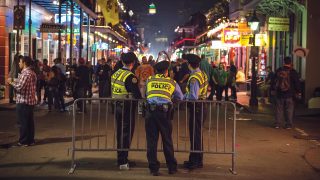
Officer intensity ranges from very low (deep sleep) to very high (extreme fear). It can be experienced very positively (e.g., increased sensory acuity during an OIS) or quite negatively (e.g., dread or outrage when falsely accused). It gives officers the motivation to hit the weights, go for that long run, study for the promotional exam, try out for the specialized unit and complete their annual wellness check with the doc. Intensity gives officers the strength, power, energy and passion to do the job, be their best selves and live another day.
Prime intensity
Prime intensity produces prime performance. You see this in sports. This is Michael Jordan being in the zone. You see this in art. This is Michelangelo being in a flow state. You see this in religion and spirituality. This is St. John of the Cross experiencing timelessness. And you see this in law enforcement. This is an officer during an OIS being fully absorbed, seeing the bullet leave the gun and travel slowly toward them, moving to get out of the way, being absent of self-consciousness. This is the ideal level of intensity for any given officer in the defense of life.
The optimal zone of performance tends to be unique for each officer. Yours will likely be different from your work partner, your spouse, a combat vet with PTSD and your neighborhood postal delivery person.
The inverted-U theory describes the relationship between intensity and performance as curvilinear (or an upside-down U). It visually shows that too little intensity yields subpar performance, and too much intensity also results in poor performance. The optimal zone — the apex or high point on the arch — is where an officer would achieve their best performance. Like with Goldilocks and the three bears, the porridge (or level of intensity) has to be just right (see Figure 1).

Overintensity
No one is in the zone 24/7. So it is important for officers to recognize less overt indications of overintensity to remain primed for optimal performance at any given moment in time.
Symptoms: Overintensity means your internal engine is over-revving. This creates excessive unproductive energy that gets wasted.
You know these symptoms. You have likely experienced one or more of them after a critical incident. These symptoms are considered “normal” in the immediate aftermath of a critical incident because your mind and your body are still coming down off the “fight or flight” chemical dump in your bloodstream. Recognizing these symptoms, at least in part, is what it takes to emotionally survive in law enforcement.
Got muscle tension? Physical symptoms may also include trembling or shaking, breathing too fast or hyperventilating, excessive thirst, profuse sweating, nausea and frequent urination.
Hypervigilant? Can’t calm down? Talking way too fast for others to keep up? Agitation, pacing, sleep or appetite disruption can also be common behavioral symptoms.
“Monkey mind” got you scattered? Racing thoughts, negative self-talk (e.g., “I am messing up!”), irrational thoughts (e.g., “If I don’t get promoted now, I never will”) and repeated “what ifs” are also common cognitive symptoms.
Irritable outbursts at home or work? Emotional symptoms may also manifest as feeling intensely angry, agitated, overwhelmed, panicky or a sense of dread.
Causes: The most frequent cause of overintensity is the negative, inaccurate, distorted, irrational cognitive assessment of the current situation. In essence, the officer thinks negatively and in an exaggerated fashion. This represents a failure to positively and accurately size up the situation at hand.
Consider a time when perhaps you have been (rightfully or falsely) accused, or you needed another surgery on that same body part or your spouse was really angry with you. Yes, the situation may be serious and in need of appropriate attention, but did you appraise the situation accurately, or did you perceive it in an extreme and negative way? Did you blow it up in your mind to be bigger and worse than it actually was? Did you perceive that you did not have the ability to cope effectively with the demands of the situation? Did you lack the confidence in your ability to handle the situation well?
The psychological challenge for any officer, regardless of the situation at work or in life, is to evaluate the situation positively and accurately and have confidence in oneself to meet the demands of
the situation effectively. A realistic perspective regulates intensity. Psychological strategies to lower overintensity may include breath control, progressive muscle relaxation, simply smiling or telling yourself certain calming key words (e.g., “breathe,” “stay cool,” “easy”).
Underintensity
Symptoms: You know the symptoms of underintensity. You have likely experienced one or more of these symptoms when working back-to-back mandatory OTs, when taking prescribed (or other) meds for pain management, or when learning about the death of a work partner or loved one. These symptoms are considered “normal” in the aftermath of such life events because your mind is still absorbing and processing the reality. Recognizing these symptoms is important to your law enforcement emotional survival.
Fatigued? What officer isn’t? But physical symptoms may also include weakness, lethargy and simply having no energy to burn.
Sleep jacked up? Slow moving? Maybe can’t even get out of bed? Behavioral symptoms may also include avoidance, being disengaged from others and withdrawn.
Difficulty focusing or concentrating? Diminished interest or pleasure in your regular activities, indecisiveness or brain fog are also common cognitive symptoms.
Grief and depression are common emotional symptoms. Feelings of confusion, detachment, uncertainty, worthlessness or guilt may also be present.
Causes: Underintensity may not be as common as overintensity in law enforcement, but it happens. If an officer is overconfident in their thoughts (e.g., “My Baker to Vegas team is going to beat everyone,” despite never practicing), or if the officer gives up in their mind (e.g., “I quit”), then intensity decreases and performance suffers. The main ingredient in intensity, once again, is the officer’s thoughts.
The psychological challenge for any officer is to maintain motivation and energy to perform while not allowing oneself to be overconfident. Psychological strategies to increase intensity may include vigorous cardio, preferably daily. Think of this as your medicine. High-energy body talk is another psychological strategy. Give high-fives, for example, to your work partner. Do fist bumps with colleagues. Jump up and down before suiting up to activate your nervous system. Finally, tell yourself certain key psych words (e.g., “Go for it!”, “Let’s rock ‘n’ roll!”, “Do it!”) to tell your mind where you want it to go, and the rest of you will follow.
How to attain optimal levels
Prime intensity produces prime performance. The right amount can help an officer save lives, including their own. Since there is no one ideal intensity level for each person, officers need to assess their own individual intensity levels when they perform well and compare them to when they perform poorly. It is as simple and as nuanced as that.
No amount of positive thinking today will make up for a lack of preparation and training. No amount of motivation today will make up for a lack of sleep and self-care. And no amount of confidence today will make up for the alcohol you consumed last night.
As seen in the March 2024 issue of American Police Beat magazine.
Don’t miss out on another issue today! Click below:





